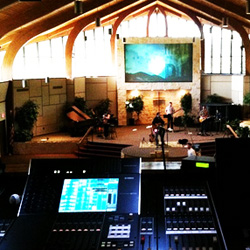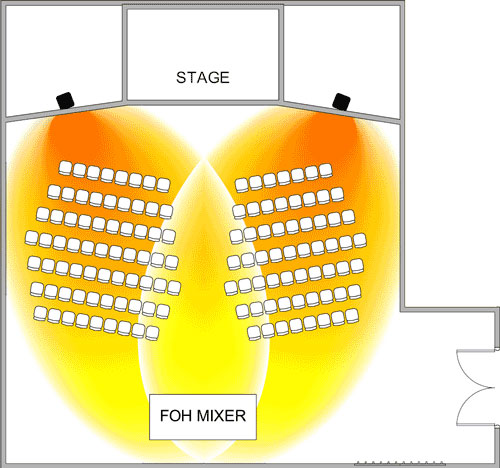
Specific Examples
Example #1: A Small Church
Description:
The ceiling is low suspended acoustic tile over an open space covered with thin carpet. The RT60 (the time it takes the reverberant sound to decrease by 60 dB) is short, so controlling reverberation is not a problem for audio clarity.
In fact, the room is a touch “dry” for music, and content of the worship service includes live musical performances.
The sources of audio are the minister with a wireless microphone and the band. Additional sources are DVD/CD players and other devices as needed. Control is via a 24-channel mixer with all inputs used.
Output is to a pair of powered loudspeakers mounted high in the corners of the room in a stereo configuration. This installation was done by members of the congregation without consultation with an audio professional.
Next, let’s look at some specific examples to bette illustrate these points.
Problems:
The quality of the audio is poor with numerous problems including uneven frequency response. An experienced sound person is required to run the mixer for all audio system use.
•Futher, there is poor coverage of the congregation from the stereo speaker pair. People sitting in the “hot spots” just in front of the loudspeakers are blasted with excessive level, and the rest of the congregation is exposed to a strong interference pattern between the two loudspeakers (Figure 12).
The system is uncompensated for room modes, room response and loudspeaker response irregularities. There is a small “sweet spot” in the center of the room where the two speakers combine coherently but there is an isle down the center of the seats. Since there are no chairs, no one is seated in the “sweet spot”.
So does this audio system work the way it is? Yes, but everyone knows the congregation may not be receiving the best possible audio experience. This example is rich in possibilities.
Recommendations:
Improvements to this system are accomplished in a number of ways. A DSP can be used for equalization, other processing and to add automation to the minister’s microphone. The entire worship band could be run through a mixer with each individual input processed by an AGC.
There are admittedly downsides to automating the audio mixing of a large group, as the automation is not as intelligent as an experienced sound person, but is possible in some cases. On addition, the loudspeaker are examined to look at options that provide more even coverage of the congregation.
Improvements to this audio system can be introduced in phases.

